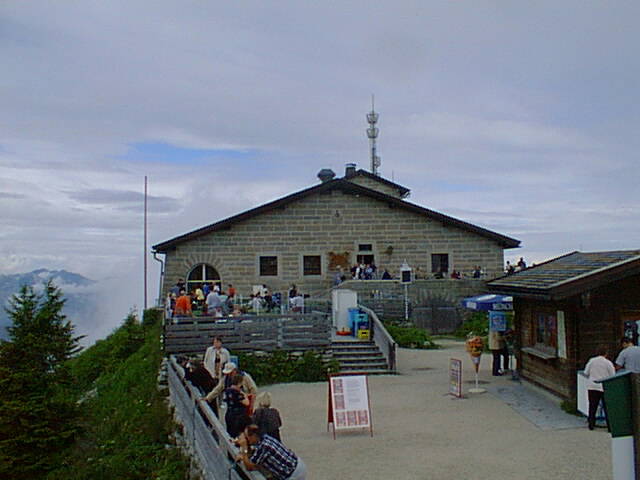
Today we left Austria for Germany, which is our last stop before heading home on Wednesday. It is not a long drive from Salzburg to Munich, so we stopped on the way to go up to the Eagle's Nest, which was a retreat built for Hitler as a gift from the Nazi Party for his 50th birthday in the late 1930's. It was built atop the mountain Kehlstein, and in German is called the Kehlsteinhaus. We reached it by driving in our regular tour buses to the town of Obersalzburg, then switching to special buses with larger engines and brakes that could handle the steep road. We then walked through a tunnel to the elevator (a nice brass affair) that took us up the last 400 feet.

This is the building itself; it was never hit during WWII, though apparently the Allies knew where it was, and the intervention of the local mayor saved it from being dynamited (to prevent its resurrection as a nationalist, Neo-Nazi shrine) afterward. The antennae and snack/souvenir stand are recent additions, but the building is pretty much the same as in the old photos of Hitler greeting visiting dignitaries; the main rooms are now a restaurant, where we ate lunch before heading back down and on to Munich. (I might note that we crossed the border from Austria to Germany, back into Austria, and then again into Germany without even having to slow down! Between nations of the European Union, travel barriers are very low, though citizens of one country still have to carry passports when visiting another, unlike United States citizens visiting Canada or Mexico, say.)
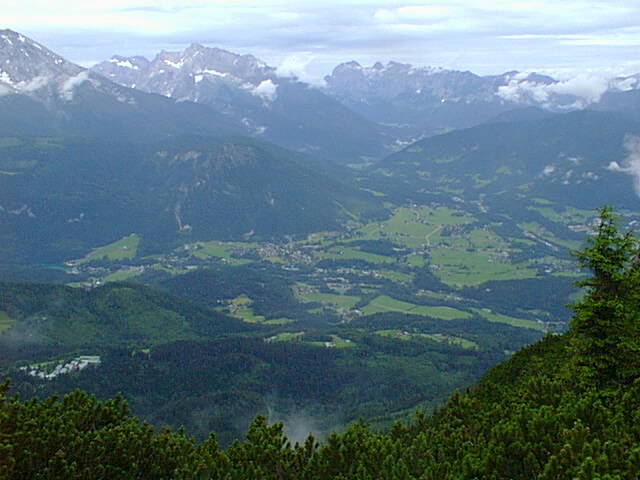
This was a typical view one could obtain from the cleared area atop the mountain. "Typical", that is, relative to the view in other directions; as far as typical viewing conditions over time, we appear to have been very lucky, as our guide had been here three or four times before and this was the first occasion when the site wasn't socked in by clouds or rain!
Next we headed to Munich, where we had a 1 1/2 hour or so sightseeing tour from the buses, followed by an hour and a half in the city center before heading to the hotel to check in. Munich is the foreign city with which I am by far the most familiar, as I was on loan from The Aerospace Corporation (my employer) to the Max Planck Institute for Extraterrestrial Physics just outside town for three months in 1994. Thus I may run on a bit about some of the interesting things in this city; I'm sure there were plenty of equally interesting things in the other cities we've visited that I passed through without being aware of at all.
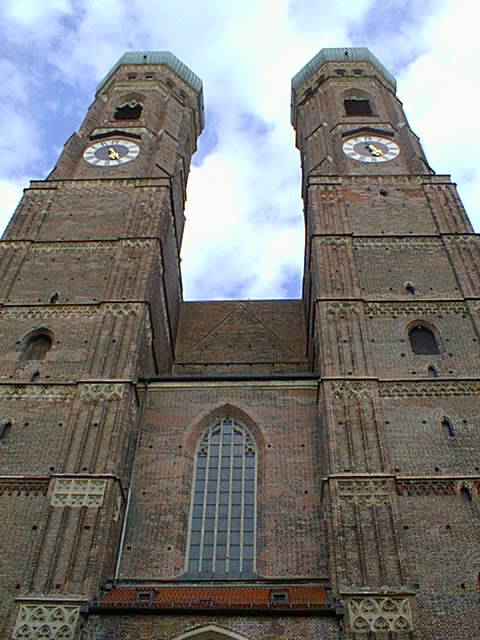
This is the Frauenkirche, the Church of Our Lady, which is the main cathedral of Munich. The citizens built it in twenty years, except that it took thirty more years to get the domes finished--still, that's blindingly fast for a structure like this. We saw, as we drove through the countryside on our way to Munich, a lot of churches with towers that echoed this domed shape.
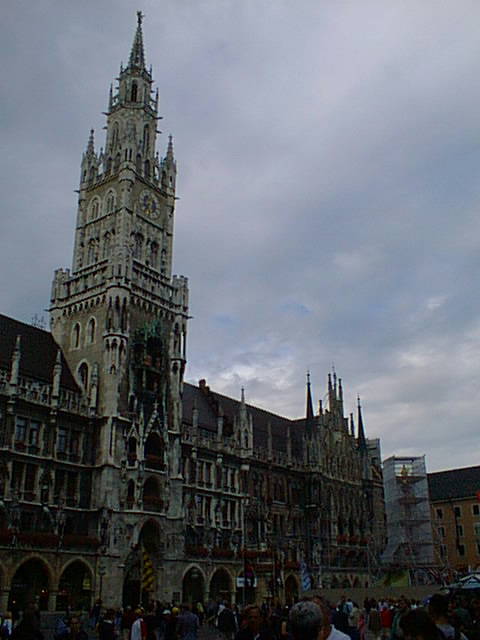
This is a view of the Neues Rathaus, the New City Hall, built in the late 19th century (the Bavarian King at the time, Ludwig II, favored very old-fashioned architectural styles; we'll see the prime example tomorrow when we visit the castle of Neuschwanstein!). The square is called the Marienplatz, after the statue of Mary on the pillar enclosed by scaffolding at the right. The statue was dedicated in 1638 in gratitude that the city had not been destroyed by invaders; the name Marienplatz was applied to the square some time later, in gratitude for deliverance from a plague.
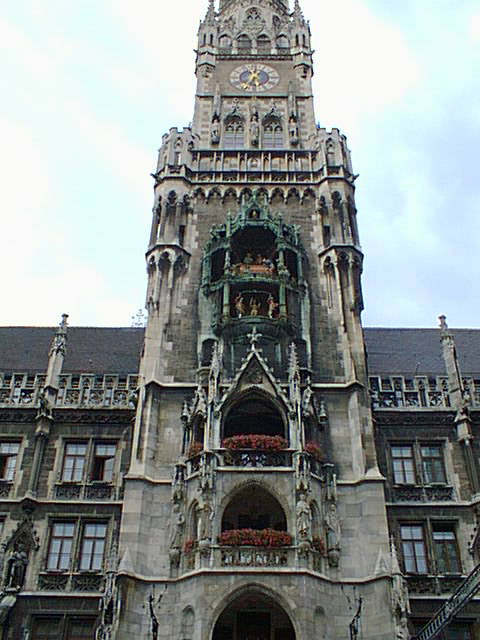
This is a somewhat closer view of the tower of the Neues Rathaus; regrettably, I have no telephoto lens for my digital camera! Above the balconies with flowers you can see two rows of figures (and a rooster in a little niche above them); these are the Glockenspiel, built in 1904, and the figures move to the tune of bells three times a day. The top row of figures depicts the wedding feast of Wilhelm V in 1568; there was a jousting match at the celebration, and as the moving figures pass the bride and groom twice, the first time the two knights miss each other, and the second time the knight in the Bavarian colors of blue and white knocks his opponent off his horse! The lower row depicts the dance of the guild of barrelmakers, reenacted every seven years at Carnival time; there was a plague in the early 16th century, and the people were afraid to come out of their houses until the barrelmakers paraded through the streets, drawing people out and bringing the city back to life. Then after the figures stop moving and the bells play a couple more songs, the rooster flaps his wings and crows to signal the end of the show!
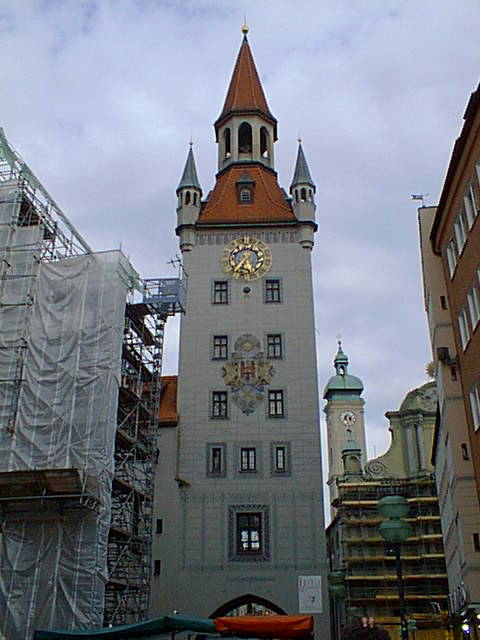
This is the tower of the Altes Rathaus, or Old City Hall; it dates back to the 15th century, and today houses a wonderful toy museum (Spielzeugmuseum). The poster to the lower right on the tower is not legible at this resolution; it advertises a special display in the toy museum on the 40th anniversary of Barbie. When I was there five years ago, I saw their exhibit on 35 years of Barbie! Actually, Barbie got her start as Bild-Lilli; Das Bild ("The Picture") is a German newspaper, and Lilli was a character in a recurring cartoon who was the inspiration for a line of dolls that developed into Barbie. The museum has, among other rarities, one of the biggest collections of Bild-Lillis and Barbies anywhere.
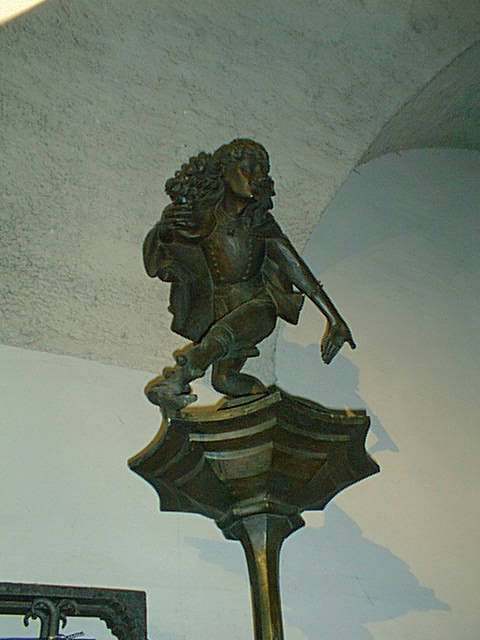
This is a little statue in a passage near the Marienplatz (on which both the old and new city halls sit, and which is the center of town); I don't think it was there five years ago, and you might not notice it while passing through, but it is a modern copy of one of my favorite bits of the city's history. In the Stadtmuseum, the City Museum, are preserved the Moriskentänzer or Morisk Dancers, which are among the greatest historical treasures of the city. These are wood carvings by Erasmus Grasser from the late 15th century, and they are all that is left of the decoration of the great hall in the Altes Rathaus, which was demolished, I don't know, long ago.
The Moriskentanz is the German variation on a theme that includes Spanish Morisque (sp?) dances and British Morris dancing; it was originally a martial dance celebrating the victory over the Moors in Spain, and those of you who went to the Madrigal Dinner that the MBCC Choir presented a couple of years back will remember some of our lads clashing quarterstaffs with each other in a Morris dance. (Was it George Jackson who sundered Darren Kikuta's staff by smiting it with a mighty blow from his own, or am I remembering it wrong?) By the time it had traveled to Germany, though, it had mutated into a grotesque pageant where wildly costumed men danced around a young woman, who had a ring which she would present to the best dancer.
There are around a dozen carvings of these dancers in the museum, each more garishly costumed than the last; the reason I particularly like them is that, well, think about the paintings you've seen from the late 15th century: very flat, static, employing no perspective. These statues could not be more different from that--each fold and train of garment is caught by the sculptor in mid-swirl! They are wonderfully alive, and I hope to get a chance to drop in on them again before we head back to America at mid-day Wednesday.
 To
Tuesday, 13 July 1999
To
Tuesday, 13 July 1999 Back
to choir tour itinerary
Back
to choir tour itinerary Back
to choir tour home page
Back
to choir tour home pagenew 12 July 1999, updated 13 July 1999